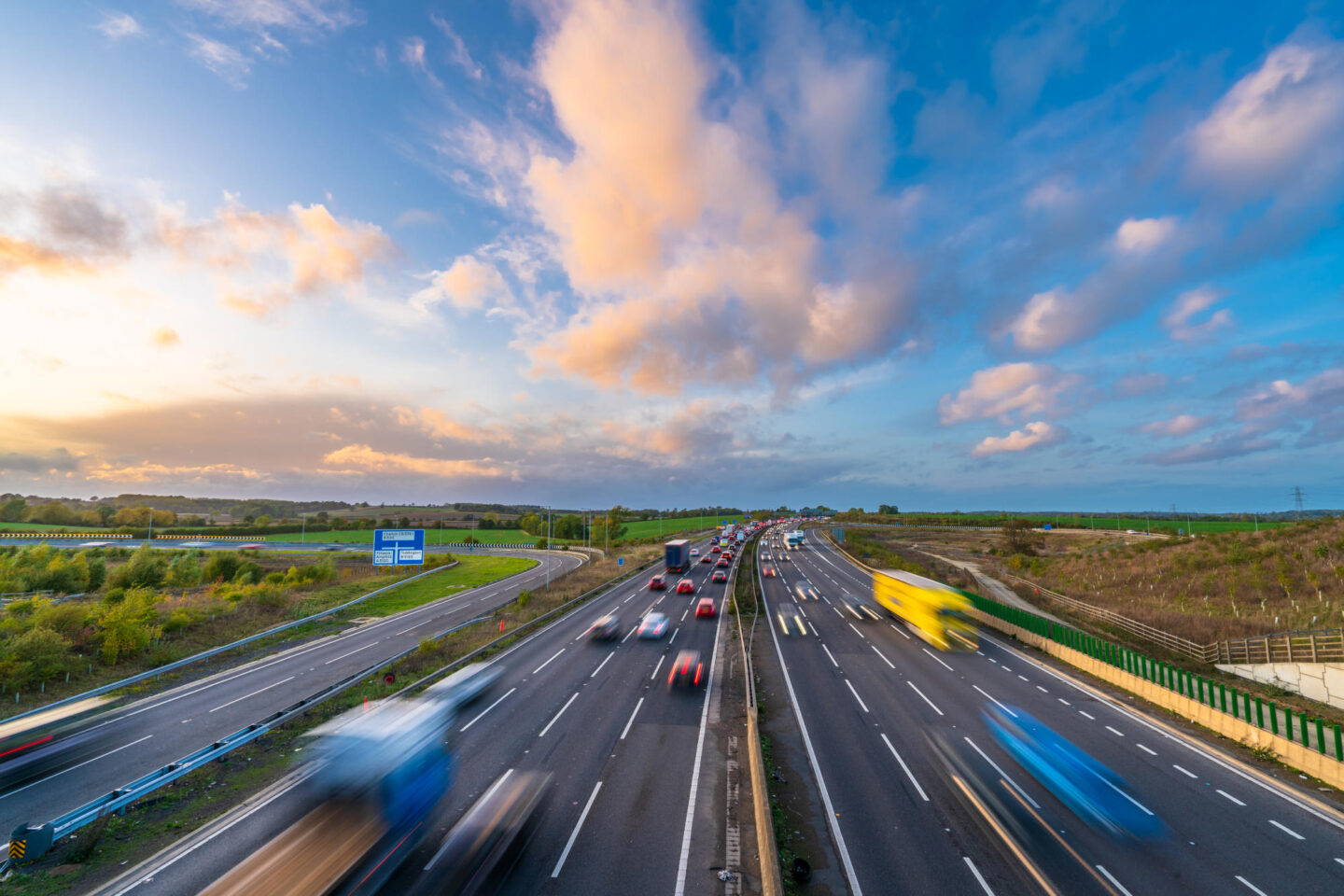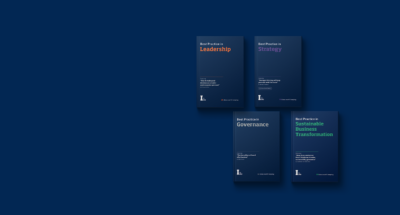
Building Better: How Baufritz is shaping the future of construction, one home at a time
Fritz-Kramer, the fourth-generation CEO of the 125-year-old family firm, is on a mission to change how Europe builds and lives more sustainably. ...

by Rob McGreevy, Marco Mueller, Michael R. Wade Published November 10, 2025 in Sustainability • 6 min read
When invited to picture a sustainable ecosystem, many people think of a rainforest with canopies of huge trees, soaring to the sky, providing shelter and food for thousands of plants and animals. Less frequently do they think of the digital nervous systems that underpin today’s business supply chains, ports, or smart cities.
But these interconnected networks of data and industrial AI are constantly at work, enabling global trade to function efficiently and effectively. At the same time, they play a vital role in decarbonizing industries and infrastructure.
Digital ecosystems hold a key to the lower-carbon future of global economies, providing the agility and resilience that businesses need to achieve net-zero targets while maintaining operational continuity in a warming world.
This shift from linear to circular collaboration makes decarbonization a shared operating requirement of connected systems.
In today’s operating environment of tariff uncertainty and ongoing economic disruption, organizations are striving to unify disparate data sources into interconnected digital networks. This helps them manage operational complexity while identifying systematic carbon reduction opportunities. We see this in the digitalization of civic transportation, port operations, and digital grid networks, which will surpass €2 trillion in EU investment by 2050.
The origins of this date back ten years, but the supply chain breakdowns of 2019-20 combined with political shocks provided an impetus for change. In Pimpri-Chinchwad, a smart city outside Pune that is also known as PCMC, digital kiosks established for traffic and parking were converted during the pandemic to issue vaccination vouchers, making PCMC the first city in the state of Maharashtra to provide vouchers to all citizens. Today, people can still access smart medical services from these kiosks alongside their parking tickets.
This shift from linear to circular collaboration makes decarbonization a shared operating requirement of connected systems. This approach creates business clusters that respond dynamically to carbon reduction opportunities while maintaining resilience during the energy transition.

“They digitalized the circulation of over one million trucks passing through annually.”
Unlocking interconnected systems for resilient decarbonization demands mastering complexity at operational and governance levels. The 2024 Antwerp Declaration establishes policy frameworks that enable collaborative decarbonization efforts.
A network becomes an ecosystem when multiple innovations happen independently and simultaneously. In Pune’s smart city, healthcare innovation built upon efficiencies originally designed for traffic, water, and communications systems, creating compound benefits for carbon reduction.
The Tranzero initiative at the Port of Gothenburg brought together port authorities and companies such as Stena, Volvo, and Scania. They digitalized the circulation of over one million trucks passing through annually. This digital foundation enables renewable power optimization. By pooling demand-side data and identifying peak demand moments, they redistribute energy consumption to less expensive times, substantially reducing the carbon intensity of peak-hour electricity.
On the US East Coast, Dominion Energy makes grid supply and demand data available in real-time to customers, enabling them to identify opportunities for renewable power use. This information helps customers fulfill net-zero commitments with verifiable grid data. In New Zealand, WaterForce developed a platform offering farmers real-time data on soil saturation, climate events, and equipment availability. Farms saved up to 50% in energy costs during the first season, directly reducing their carbon footprint while optimizing yields.
However, these initiatives remain at the cluster level – they only become true digital ecosystems when they are joined by other power suppliers and farms to become collaborative clusters, together focused on resilient decarbonization.
The model brings together data on inputs, outputs, waste, and emissions.
Digital ecosystems enable efficient tracking and reduction of direct Scope 1 and utility-related Scope 2 emissions, but their real potential lies in optimizing supply chain-based Scope 3 emissions, by far the largest global contributor to greenhouse gas emissions. Integrated data and industrial AI facilitate monitoring and information collection that drives Scope 3 reduction across business clusters.
The Port of Kwinana in Australia created an industrial intelligence platform to visualize and optimize a circular model for port businesses. The model brings together data on inputs, outputs, waste, and emissions. The objectives focused on creating governance frameworks for emissions reduction, demonstrating the value of enhanced carbon tracking, and proving that circular economy principles drive measurable decarbonization in industrial clusters.
With a detailed understanding of collective inputs, outputs, and emissions, the cluster can optimize at a systems level. This enables resource efficiency with measurable emissions reduction across the value chain.

These examples share common elements: interoperability, trust, and focus on carbon reduction benefits. The urgent need to achieve resilient decarbonization drives these initiatives, particularly as energy costs rise and supply chains face disruption. For example, Gothenburg’s digital cluster embraces an “energy commons” concept to accelerate carbon reduction for all participants.
Connected ecosystems require shared vision and aligned sustainability goals. Businesses must create a unified digital infrastructure supported by AI capabilities that handle interconnected datasets while providing teams with real-time data for carbon-conscious decisions.
As grid demands grow from datacenters and AI, the ability to extract insights for carbon optimization becomes critical. Governance foundations ensure that long-term sustainability benefits aren’t sacrificed for short-term gains. This transition demands a fundamental shift in how organizations approach decarbonization.
This mindset of collaboration for systemic decarbonization is founded on cold, hard economics.
The need for shared vision, integrated data that underpins AI and carbon tracking insights, and robust regulatory frameworks all point to one conclusion: the bedrock of successful business ecosystems is founded on not digital but neural networks. For all that digital systems provide the essential hard-wiring that underpins decarbonization, it is how leaders think about this new way of working that can accelerate measurable innovation. Those driving change must recognize that openness and interoperability are essential to achieving carbon reduction at scale.
This mindset of collaboration for systemic decarbonization is founded on cold, hard economics. The costs of uncoordinated carbon reduction efforts far exceed those of ecosystem-based approaches. In the sustainable digital ecosystem, as in the rainforest, only the most adaptive will thrive in a carbon-constrained future.
This article is part of an ongoing research collaboration between IMD and AVEVA focused on digital ecosystems and industrial intelligence.
All views expressed herein are those of the authors and have been specifically developed and published in accordance with the principles of academic freedom. As such, such views are not necessarily held or endorsed by TONOMUS or its affiliates.

Chief Product Officer, AVEVA
As Chief Product Officer, Rob McGreevy leads the product management and business unit teams to drive innovative software solutions across the business, McGreevy has over 25 years of experience working in the industrial software business with a focus on manufacturing and infrastructure, serving end-markets such as power, water, food, beverage, pharmaceutical, and energy. With an extensive background in product and business management, M&A, sales, and marketing, he is named in over 28 software and technology patents.

Chief Marketing Officer
Marco Mueller is AVEVA’s Chief Marketing Officer, having joined in 2022. Mueller is an expert in building highly motivated teams within a globally matrixed environment. He champions innovation and transformation, creating integrated channels to support cross-functional marketing programs that maximize customer focus and impact. Prior to AVEVA, he held senior roles in Service Now, SAP SE, and Accenture, working in the Americas, EMEA, APJ and China.

TONOMUS Professor of Strategy and Digital
Michael R Wade is Professor of Strategy and Digital at IMD and Director of the Global Center for Digital and AI Transformation. He directs a number of open programs such as Leading Digital and AI Transformation, Digital Transformation for Boards, Leading Digital Execution, Digital Transformation Sprint, Digital Transformation in Practice, Business Creativity and Innovation Sprint. He has written 10 books, hundreds of articles, and hosted popular management podcasts including Mike & Amit Talk Tech. In 2021, he was inducted into the Swiss Digital Shapers Hall of Fame.

December 12, 2025 • by Julia Binder, Manuel Braun in Sustainability
Fritz-Kramer, the fourth-generation CEO of the 125-year-old family firm, is on a mission to change how Europe builds and lives more sustainably. ...

December 2, 2025 in Sustainability
Four books bring together the best I by IMD articles on leadership, strategy, governance, and sustainable business transformation. ...

December 1, 2025 • by Julia Binder, Knut Haanaes in Sustainability
In the second episode of IMD’s sustainability series, IMD's Julia Binder and Knut Haanaes welcome Kunal Chandra of RWE to discuss the energy transition....

November 27, 2025 • by Amanda Williams in Sustainability
Companies have buckled under pressure from the Trump administration and challenging economic conditions, but now's not the time to abandon sustainability goals....
 Audio available
Audio availableExplore first person business intelligence from top minds curated for a global executive audience